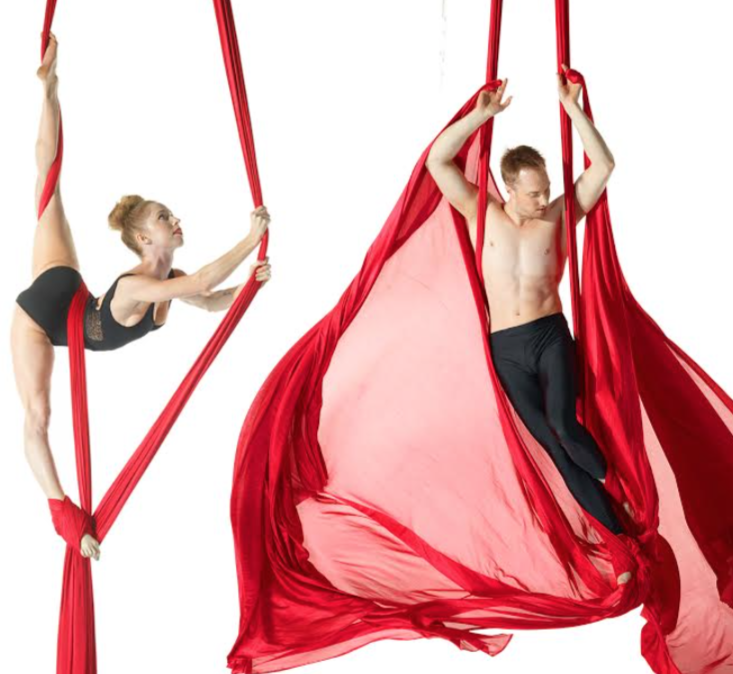We have all experienced at least one day where we wake up, attempt to throw the covers off and ‘seize the day’ before falling immediately back onto our pillow groaning, convinced we were hit by a bus during our sleep!
The culprit? A tough aerial class or training sesh, a performance that involved multiple same-day rehearsals or even our cross-training ventures at Orange Theory, Soul Cycle or ‘Buns n’ Guns of Steel!’ (anybody? Hmmm… Maybe that last ones just us).
 As aerialists and aerial students rest and recovery is just as important as training in order to stay healthy, injury-free and in peak performance condition.
As aerialists and aerial students rest and recovery is just as important as training in order to stay healthy, injury-free and in peak performance condition.
Think of your aerial training like taking money out of the bank and recovery is your savings account. If you continue to take money out of the bank without replacing it, you’ll eventually have no money left.
Lets take a look at some of the ways we can improve the quality of our recovery in order to optimize our aerial training and fulfill our performance potential.
5 Recovery Tips for Optimal Aerial Performance
1. Get More Sleep.
Multiple scientific studies suggest that sleep deprivation can have a significantly negative effect on performance and recovery. Sleep is also prime time for the body to undergo protein synthesis; so getting extra zzzs after a tough aerial workout might make for stronger muscles and better endurance.
Research also suggests that taking a nap around two hours after a workout helps the body enter deep, restorative states of sleep. Here at W&B we LOVE a 15-25 minute nap after training on a performance day as it helps restore and energize our bodies ready for the show to come.
2. Roll it Out
Much of the soreness that goes along with aerial training occurs when our muscles and fascia—connective tissue running throughout the body—become knotted. Rolling out muscles with foam or semi-rigid rollers—two forms of self-myofascial release—can help remove those knots and prevent muscle imbalances from forming. While not the most comfortable hurts-so-good experience, the benefits are worth it.
3. Warm-Up and Cool-Down
The majority of injuries sustained by aerialists and athletes in general occur when we are moving through rapid changes in range of motion, rather than while stationary or moving slowly through a range of motion. Additionally, injuries typically occur when multiple joints are moving simultaneously and when aerialists are in weight-bearing positions (many times upside down!)
With that being said, our warm-up and cool-down routines should focus primarily on mobility exercises that are weight bearing, multi-joint movements and should encourage us to progressively move through a full range of motion.
An example of an excellent warm-up/cool down for aerialists is Vinyasa Yoga which co-ordinates the breath with fluid, full-body movements and stretches.
If you feel that you need more time before and after aerial class to thoroughly warm up and cool down, arrive 15 minutes early and stay late in order to effectively activate and stretch every muscle and joint.
4. Eat Protein Before Training
Amino acids are the building blocks of muscle tissue, and we need to consume protein to give our bodies enough to rebuild and maintain muscles damaged during training sessions. Having a small amount of protein before class/training can trigger our bodies to start muscle synthesis (repairing and building more muscle) throughout and even after working out.
5. Try Cold Therapy
While it might be a scary prospect, research suggests taking a cold, full-body plunge after working out can significantly reduce soreness and inflammation for up to 24 hours after exercise.
Here at W&B we have experimented with Cryotherapy treatment to speed up muscle restoration and are big fans of this relatively new recovery tool (recommended by the LA Lakers and Tony Robins among others). If you don’t have access to a Cryo chamber (or the thought of freezing your entire body for 2 minutes doesn’t sound appealing) stick with the ice baths and/or ice packs to help those sore aerial muscles recover faster and stay healthy and strong.

Try some or all of these recovery tips and let us know how you get on by tweeting us @womackandbowman with the hash tag #recoverytips
Here’s to you and your peak performance!
Much love,
Brett and Rache







